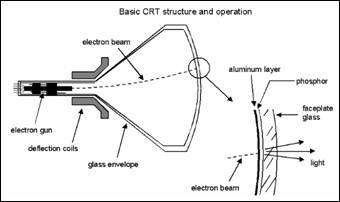
Concept explainers
Interpretation:
The details of the cathode ray tube and its function are to be explained.
Concept introduction:
In the cathode ray, the high speed beam of electrons are passed through a vacuum tube and hit at the end of the tube. Cathode ray tube generate images on the screen by the high speed revolution of electronic beam.
Answer to Problem 91A
Cathode ray tube is a vacuum system to form images on the television and computer screen. It works on the basis of high velocity electron rotation.
Explanation of Solution
The main three part of CRT which can define the function of cathode ray tube are:
- Electron Gun.
- Deflection system.
- Fluorescent screen.
Electron Gun − The high electronic beam is generated is produced in this part of tube. When the high voltage filament in the cathode emit electron, the emission of beam is created by thermionic emission and anode accelerates the electron towards the screen.
Deflection system - The position of electron is controlled under electronic or magnetic field. The applied high voltage in the tube, control the deflection electrostatic effect.
Fluorescent screen − The screen displays images by the fall down of the electron on the screen. The screen is coated by zinc sulfide or phosphorus. This screen emits light when the high electronic flow fall down on the screen.

The division of cathode ray tubeplaysan important role in producing the images on the coated screen. The electronic flow is the major portion of CRT to help the display of images on the television screen or computer screen.
Chapter 4 Solutions
Chemistry: Matter and Change
Additional Science Textbook Solutions
General, Organic, and Biological Chemistry (3rd Edition)
CHEMISTRY-TEXT
Organic Chemistry
General Chemistry: Principles and Modern Applications (11th Edition)
Chemistry: The Central Science (14th Edition)
Chemistry: The Central Science (13th Edition)
 ChemistryChemistryISBN:9781305957404Author:Steven S. Zumdahl, Susan A. Zumdahl, Donald J. DeCostePublisher:Cengage Learning
ChemistryChemistryISBN:9781305957404Author:Steven S. Zumdahl, Susan A. Zumdahl, Donald J. DeCostePublisher:Cengage Learning ChemistryChemistryISBN:9781259911156Author:Raymond Chang Dr., Jason Overby ProfessorPublisher:McGraw-Hill Education
ChemistryChemistryISBN:9781259911156Author:Raymond Chang Dr., Jason Overby ProfessorPublisher:McGraw-Hill Education Principles of Instrumental AnalysisChemistryISBN:9781305577213Author:Douglas A. Skoog, F. James Holler, Stanley R. CrouchPublisher:Cengage Learning
Principles of Instrumental AnalysisChemistryISBN:9781305577213Author:Douglas A. Skoog, F. James Holler, Stanley R. CrouchPublisher:Cengage Learning Organic ChemistryChemistryISBN:9780078021558Author:Janice Gorzynski Smith Dr.Publisher:McGraw-Hill Education
Organic ChemistryChemistryISBN:9780078021558Author:Janice Gorzynski Smith Dr.Publisher:McGraw-Hill Education Chemistry: Principles and ReactionsChemistryISBN:9781305079373Author:William L. Masterton, Cecile N. HurleyPublisher:Cengage Learning
Chemistry: Principles and ReactionsChemistryISBN:9781305079373Author:William L. Masterton, Cecile N. HurleyPublisher:Cengage Learning Elementary Principles of Chemical Processes, Bind...ChemistryISBN:9781118431221Author:Richard M. Felder, Ronald W. Rousseau, Lisa G. BullardPublisher:WILEY
Elementary Principles of Chemical Processes, Bind...ChemistryISBN:9781118431221Author:Richard M. Felder, Ronald W. Rousseau, Lisa G. BullardPublisher:WILEY





